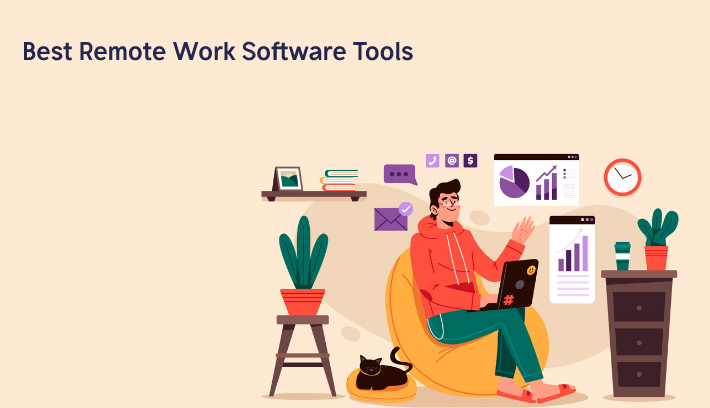Remote working seems fun. At least that is what I thought when I was granted the opportunity to work remotely. However, in just a few days I realized that there was a lot more to unpack than most people realize.
Starting off, I figured that remote work was pushing me into isolation. I felt lonely, disconnected from the team, and struggling with simple tasks. Another important issue was time management. While I was excellent at time management in the office, I felt the time was slipping through my fingers and there were still pending tasks by the end of the day.
So, what was I lacking?
If you are guessing discipline, you might be on to something.
Technically, remote work requires a lot of effort, good time management skills, and time tracking. All this can be achieved by choosing the right tech, equipment, and software.
If you are starting your remote journey, or you are a freelancer enjoying the convenience of working from home, this write-up will explore some of the basic tech tools, equipment, and software to ease the virtual working experience.
Remote Work — Tech Equipment Starter Pack
For remote work, you need a good device i.e. laptop, and reliable internet. Most remote employees get issued work devices i.e. laptops, iPads, or tablets from the office. These devices come equipped with all the essential software for communication, time tracking, and overall task management.
However, in some cases, the company allows the employee to pick the device.
If you have the option of choosing your own device, keep in mind that heavy-duty tech work especially coding, UI/UX, and development requires a powerful computer. However, if you are working as a content creator, or social media manager or you have a marketing job, you don’t need a heavy-duty, sophisticated device.
The second most important thing you will need is the internet. While business internet might feel like an obvious choice, keep in mind that a good residential internet is enough to fulfill your needs as a remote worker.
If you are currently looking for good internet for work from home, Xfinity Internet is a suitable option. The ISP offers a broad range of internet plans with different download and upload speeds at affordable rates. Users can easily choose the best internet package based on the price range, functionalities, and speed limit.
Top Tech Tools and Software to Explore For Seamless Remote Working
Now that you have the equipment needed for the perfect remote work set-up, here are some of the tools you should have when working from home.
Team Collaboration Tools
Remote work is impossible without team collaboration software. Most companies have their own communication channels where they have dedicated group chats to share ideas and gather updates on the running projects.
Platforms like Slack and Teams are considered best for one-on-one or group communication. Both these platforms offer features like live chat, video calls, file sharing, etc. The best part is that you can easily integrate these platforms into third-party task management tools as well.
Overall, team collaboration tools work as your first line of communication and collaboration. Through these tools, you can easily brainstorm ideas, share your screen to work on ideas, and move forward with your work.
Data Sharing Tools
Data storage and sharing is one of the biggest issues related to business. Since data requires a lot of space and is generally considered sensitive, companies use special tools to offer selective access. Storage solutions like Google Drive, Dropbox, and OneDrive are considered ideal for remote workers who want to share data.
All these tools help not only in storing data and sharing files, but are ideal for securing data and offering exclusive access. Moreover, there is a real-time edit option that allows the team members on the same project to easily edit and update files.
These storage ideas are especially ideal for companies that lose data or fail to make a backup. Since the editing is done virtually, every edit is saved automatically ensuring not a single change goes to waste.
Video Conferencing
For remote workers, video conference or call meetings work as the lifeline. Online communication software like Zoom and Google Meet are considered best for video conferencing so far. Skype was also one of the best video conferencing tools. However, the tool was retired after Microsoft purchased it, with Teams acting as a replacement.
Since most of these tools are free, anyone can use them. Moreover, recruitment companies, education institutes, and development teams who want to work in real-time can benefit from these video conferencing tools.
Project and Task Management
While working on big projects, keeping track of the tasks and the progress of work becomes quite a challenge. This issue is not just limited to big projects. Freelancers working on multiple ventures simultaneously also face the same issue.
A quick and easy solution to this issue is project and task management tools like Asana, Jira, and Trello.
All these dashboards allow the project managers to assign tasks, track task progress, read the basic blueprint, and extract reports. The best thing about these tools is that they can be used for both large and small businesses and they help in creating seamless workflow.
Time Management
Time management is one of the biggest issues when it comes to remote work. The majority of the remote workers get distracted, which means they end up wasting time. To handle this issue, apps like Clockify and RescueTime are ideal.
These apps help in tracking time, ensuring that the worker stays productive throughout the office time. Moreover, these tools can be integrated with app blocking and restricting sites, so it is easier to stay focused on work.
Simply put, this write-up covers the basic tools ideal for tech jobs. If you are working on sophisticated projects, it is better to explore other tools as well that suit the nature of your business.
